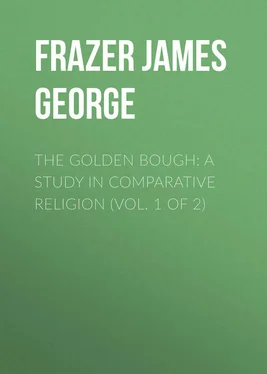James Frazer - The Golden Bough - A Study in Comparative Religion (Vol. 1 of 2)
Здесь есть возможность читать онлайн «James Frazer - The Golden Bough - A Study in Comparative Religion (Vol. 1 of 2)» — ознакомительный отрывок электронной книги совершенно бесплатно, а после прочтения отрывка купить полную версию. В некоторых случаях можно слушать аудио, скачать через торрент в формате fb2 и присутствует краткое содержание. Жанр: foreign_religion, foreign_antique, foreign_prose, на английском языке. Описание произведения, (предисловие) а так же отзывы посетителей доступны на портале библиотеки ЛибКат.
- Название:The Golden Bough: A Study in Comparative Religion (Vol. 1 of 2)
- Автор:
- Жанр:
- Год:неизвестен
- ISBN:нет данных
- Рейтинг книги:4 / 5. Голосов: 1
-
Избранное:Добавить в избранное
- Отзывы:
-
Ваша оценка:
- 80
- 1
- 2
- 3
- 4
- 5
The Golden Bough: A Study in Comparative Religion (Vol. 1 of 2): краткое содержание, описание и аннотация
Предлагаем к чтению аннотацию, описание, краткое содержание или предисловие (зависит от того, что написал сам автор книги «The Golden Bough: A Study in Comparative Religion (Vol. 1 of 2)»). Если вы не нашли необходимую информацию о книге — напишите в комментариях, мы постараемся отыскать её.
The Golden Bough: A Study in Comparative Religion (Vol. 1 of 2) — читать онлайн ознакомительный отрывок
Ниже представлен текст книги, разбитый по страницам. Система сохранения места последней прочитанной страницы, позволяет с удобством читать онлайн бесплатно книгу «The Golden Bough: A Study in Comparative Religion (Vol. 1 of 2)», без необходимости каждый раз заново искать на чём Вы остановились. Поставьте закладку, и сможете в любой момент перейти на страницу, на которой закончили чтение.
Интервал:
Закладка:
Again, the fructifying power of the tree is put forth at seed-time as well as at harvest. Among the Aryan tribes of Gilgit, on the north-western frontier of India, the sacred tree is the Chili , a species of cedar ( Juniperus excelsa ). At the beginning of wheat-sowing the people receive from the Raja's granary a quantity of wheat, which is placed in a skin mixed with sprigs of the sacred cedar. A large bonfire of the cedar wood is lighted, and the wheat which is to be sown is held over the smoke. The rest is ground and made into a large cake, which is baked on the same fire and given to the ploughman. 262 262 Biddulph, Tribes of the Hindoo Koosh , p. 103 sq.
Here the intention of fertilising the seed by means of the sacred cedar is unmistakable. In all these cases the power of fostering the growth of crops, and, in general, of cultivated plants, is ascribed to trees. The ascription is not unnatural. For the tree is the largest and most powerful member of the vegetable kingdom, and man is familiar with it before he takes to cultivating corn. Hence he naturally places the feebler and, to him, newer plant under the dominion of the older and more powerful.
Again, the tree-spirit makes the herds to multiply and blesses women with offspring. The sacred Chili or cedar of Gilgit was supposed to possess this virtue in addition to that of fertilising the corn. At the commencement of wheat-sowing three chosen unmarried youths, after undergoing daily washing and purification for three days, used to start for the mountain where the cedars grew, taking with them wine, oil, bread, and fruit of every kind. Having found a suitable tree they sprinkled the wine and oil on it, while they ate the bread and fruit as a sacrificial feast. Then they cut off the branch and brought it to the village, where, amid general rejoicing, it was placed on a large stone beside running water. “A goat was then sacrificed, its blood poured over the cedar branch, and a wild dance took place, in which weapons were brandished about, and the head of the slaughtered goat was borne aloft, after which it was set up as a mark for arrows and bullet-practice. Every good shot was rewarded with a gourd full of wine and some of the flesh of the goat. When the flesh was finished the bones were thrown into the stream and a general ablution took place, after which every man went to his house taking with him a spray of the cedar. On arrival at his house he found the door shut in his face, and on his knocking for admission, his wife asked, ‘What have you brought?’ To which he answered, ‘If you want children, I have brought them to you; if you want food, I have brought it; if you want cattle, I have brought them; whatever you want, I have it.’ The door was then opened and he entered with his cedar spray. The wife then took some of the leaves and pouring wine and water on them placed them on the fire, and the rest were sprinkled with flour and suspended from the ceiling. She then sprinkled flour on her husband's head and shoulders, and addressed him thus: ‘Ai Shiri Bagerthum, son of the fairies, you have come from far!’ Shiri Bagerthum , ‘the dreadful king,’ being the form of address to the cedar when praying for wants to be fulfilled. The next day the wife baked a number of cakes, and taking them with her, drove the family goats to the Chili stone. When they were collected round the stone, she began to pelt them with pebbles, invoking the Chili at the same time. According to the direction in which the goats ran off, omens were drawn as to the number and sex of the kids expected during the ensuing year. Walnuts and pomegranates were then placed on the Chili stone, the cakes were distributed and eaten, and the goats followed to pasture in whatever direction they showed a disposition to go. For five days afterwards this song was sung in all the houses: —
‘Dread Fairy King, I sacrifice before you,
How nobly do you stand! you have filled up my house,
You have brought me a wife when I had not one,
Instead of daughters you have given me sons.
You have shown me the ways of right,
You have given me many children.’ ” 263 263 Biddulph, op. cit. p. 106 sq.
Here the driving of the goats to the stone on which the cedar had been placed is clearly meant to impart to them the fertilising influence of the cedar. In Europe the May-tree (May-pole) is supposed to possess similar powers over both women and cattle. In some parts of Germany on the 1st of May the peasants set up May-trees at the doors of stables and byres, one May-tree for each horse and cow; this is thought to make the cows yield much milk. 264 264 Mannhardt, B. K. p. 161; E. Meier, Deutsche Sagen, Sitten und Gebräuche aus Schwaben , p. 397.; A. Peter, Volksthümliches aus Österreichisch-Schlesien , ii. 286; Reinsberg-Düringsfeld, Fest-Kalendar aus Böhmen , p. 210.
Camden says of the Irish, “They fancy a green bough of a tree, fastened on May-day against the house, will produce plenty of milk that summer.” 265 265 Quoted by Brand, Popular Antiquities , i. 227, Bohn's ed.
On the 2d of July some of the Wends used to set up an oak-tree in the middle of the village with an iron cock fastened to its top; then they danced round it, and drove the cattle round it to make them thrive. 266 266 Mannhardt, B. K. p. 174.
Some of the Esthonians believe in a mischievous spirit called Metsik, who lives in the forest and has the weal of the cattle in his hands. Every year a new image of him is prepared. On an appointed day all the villagers assemble and make a straw man, dress him in clothes, and take him to the common pasture land of the village. Here the figure is fastened to a high tree, round which the people dance noisily. On almost every day of the year prayer and sacrifice are offered to him that he may protect the cattle. Sometimes the image of Metsik is made of a corn-sheaf and fastened to a tall tree in the wood. The people perform strange antics before it to induce Metsik to guard the corn and the cattle. 267 267 Holzmayer, “Osiliana,” Verhandlungen der Estnischen Gesell. zu Dorpat , vii. 10 sq. ; Mannhardt, B. K. p. 407 sq.
The Circassians regard the pear-tree as the protector of cattle. So they cut down a young pear-tree in the forest, branch it, and carry it home, where it is adored as a divinity. Almost every house has one such pear-tree. In autumn, on the day of the festival, it is carried into the house with great ceremony to the sound of music and amid the joyous cries of all the inmates, who compliment it on its fortunate arrival. It is covered with candles, and a cheese is fastened to its top. Round about it they eat, drink, and sing. Then they bid it good-bye and take it back to the courtyard, where it remains for the rest of the year, set up against the wall, without receiving any mark of respect. 268 268 Potocki, Voyage dans les steps d'Astrakhan et du Caucase (Paris, 1829), i. 309.
The common European custom of placing a green bush on May Day before the house of a beloved maiden probably originated in the belief of the fertilising power of the tree-spirit. 269 269 Mannhardt, B. K. p. 163 sqq. To his authorities add, for Sardinia, R. Tennant, Sardinia and its Resources (Rome and London, 1885), p. 185 sq.
Amongst the Kara-Kirgiz barren women roll themselves on the ground under a solitary apple-tree, in order to obtain offspring. 270 270 Radloff, Proben der Volkslitteratur der nördlichen Türkischen Stämme , v. 2.
Lastly, the power of granting to women an easy delivery at child-birth is ascribed to trees both in Sweden and Africa. In some districts of Sweden there was formerly a bårdträd or guardian-tree (lime, ash, or elm) in the neighbourhood of every farm. No one would pluck a single leaf of the sacred tree, any injury to which was punished by ill-luck or sickness. Pregnant women used to clasp the tree in their arms in order to ensure an easy delivery. 271 271 Mannhardt, B. K. p. 51 sq.
In some negro tribes of the Congo region pregnant women make themselves garments out of the bark of a certain sacred tree, because they believe that this tree delivers them from the dangers that attend child-bearing. 272 272 Merolla, “Voyage to Congo,” in Pinkerton's Voyages and Travels , xvi. 236 sq.
The story that Leto clasped a palm-tree and an olive-tree or two laurel-trees when she was about to give birth to Apollo and Artemis perhaps points to a similar Greek belief in the efficacy of certain trees to facilitate delivery. 273 273 Bötticher, Der Baumkultus der Hellenen , p. 30 sq.
Интервал:
Закладка:
Похожие книги на «The Golden Bough: A Study in Comparative Religion (Vol. 1 of 2)»
Представляем Вашему вниманию похожие книги на «The Golden Bough: A Study in Comparative Religion (Vol. 1 of 2)» списком для выбора. Мы отобрали схожую по названию и смыслу литературу в надежде предоставить читателям больше вариантов отыскать новые, интересные, ещё непрочитанные произведения.
Обсуждение, отзывы о книге «The Golden Bough: A Study in Comparative Religion (Vol. 1 of 2)» и просто собственные мнения читателей. Оставьте ваши комментарии, напишите, что Вы думаете о произведении, его смысле или главных героях. Укажите что конкретно понравилось, а что нет, и почему Вы так считаете.












